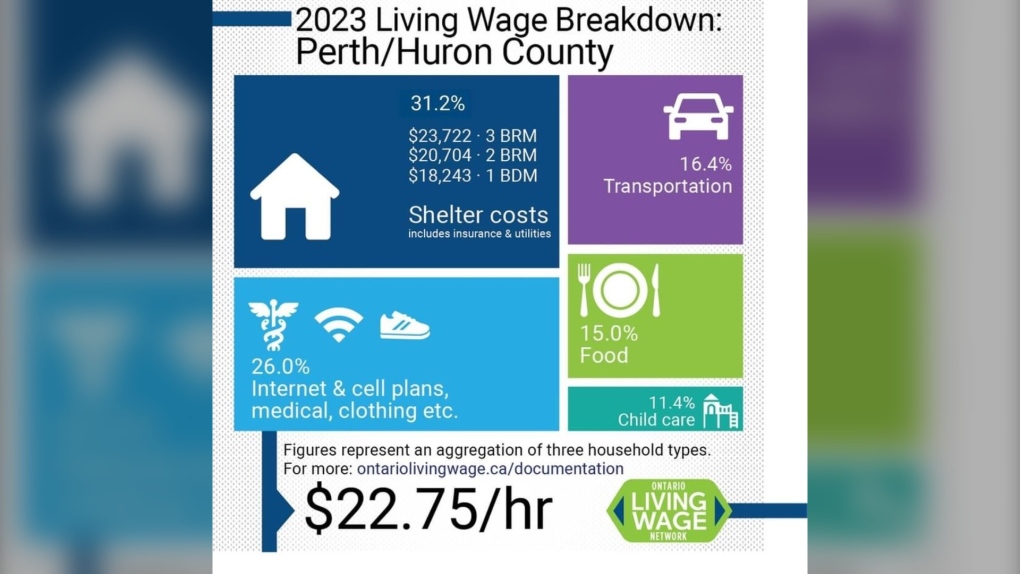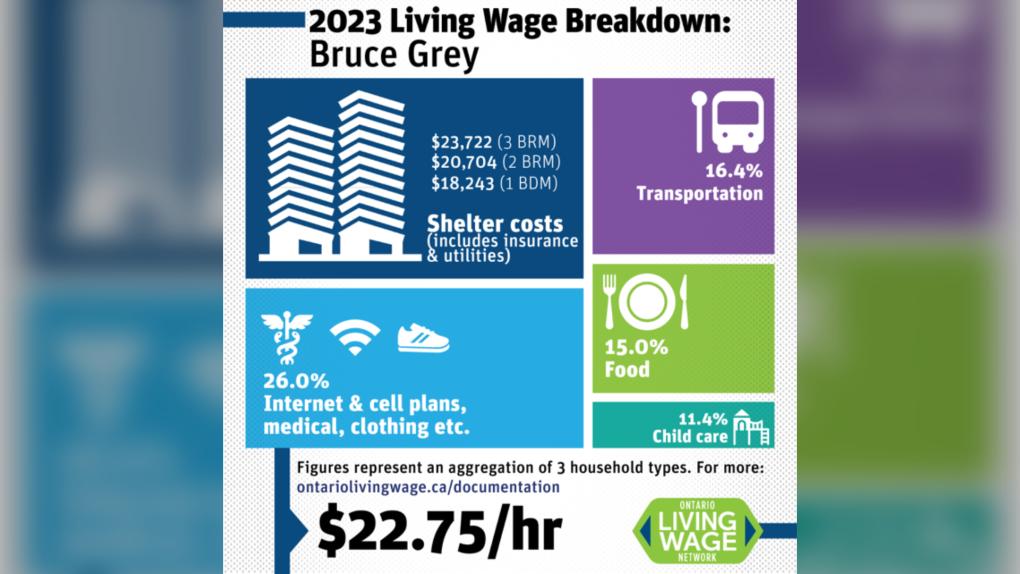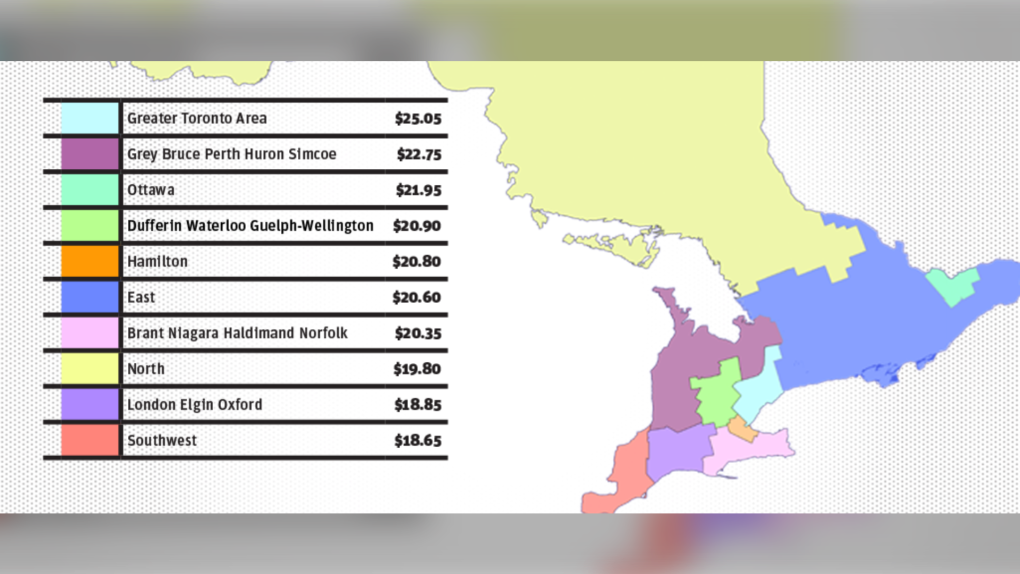It's not cheaper to call rural Ontario home, living wage report says
Most people believe that once you leave the city limits the cost of living drops — but that’s simply not the case.
“Bruce-Grey-Huron-Perth-Simcoe is the second highest now in terms of what a living wage is, what it costs to live in a rural community. And it’s a 9.6 per cent increase over last year,” explained Francesca Dobbyn, executive director of the United Way of Bruce-Grey.
The Greater Toronto Area is the only region in southern Ontario with a higher cost of living than midwestern Ontario, which hit $22.75 an hour this year, up from $20.70 last year.
Places like London-Oxford-Elgin and Windsor-Essex, at $18.85 and $18.65 an hour, have the lowest living wages required for families to pay basic bills, such as food, shelter and transportation.
“It is not cheaper to live in rural Ontario. It’s a stereotype that you’ve got farmers near you, so food will be cheaper. It’s simply not. We don’t have employment friendly transportation between communities, so it’s a challenge to hold down a job without a vehicle,” said Dobbyn.
 Living wages across Ontario rise by double digits, in most areas, thanks to increased housing and food costs. Here is the living wage breakdown for Huron-Perth in 2023. (Source: Ontario Living Wage Network)
Living wages across Ontario rise by double digits, in most areas, thanks to increased housing and food costs. Here is the living wage breakdown for Huron-Perth in 2023. (Source: Ontario Living Wage Network)
If you think the yearly calculation of living wages — done by the Ontario Living Wage Network in conjunction with United Ways across the province — only impacts a small fraction of the population, that’s also not correct, according to Ryan Erb, with the United Way of Perth-Huron.
“The United Way calculates annually the statistic around this, and we know that about half our community are living on less than the local living wage,” said Erb.
It’s not just the extra cost of transportation in rural Ontario that’s pushed up the cost of living, shelter in particular is no longer “cheaper” outside of urban boundaries.
 Living wages across Ontario rise by double digits, in most areas, thanks to increased housing and food costs. Here is the living wage breakdown for Grey-Bruce in 2023. (Source: Ontario Living Wage Network)
Living wages across Ontario rise by double digits, in most areas, thanks to increased housing and food costs. Here is the living wage breakdown for Grey-Bruce in 2023. (Source: Ontario Living Wage Network)
“The cost of housing has gone through the roof for our region. The out migration of people from urban area [and] the lack of rentals is really driving up a lot of costs. We have an increase in homelessness. More people holding down jobs, but classified as homeless because they’re living in their car or couch surfing. We work with people everyday who can’t afford their utilities. Rent is eating up everything they have,” said Dobbyn.
Dobbyn and Erb said more employers than ever have signed up to pay their employees a living wage, but that can also add to the costs of goods, transportation and food.
Right now, the rising cost of living is a question with not many answers.
 A graphic illustrating the living wages in 2023 for regions across Ontario. (Source: Ontario Living Wage Network)
A graphic illustrating the living wages in 2023 for regions across Ontario. (Source: Ontario Living Wage Network)
CTVNews.ca Top Stories

opinion Tom Mulcair: Prime Minister Justin Trudeau's train wreck of a final act
In his latest column for CTVNews.ca, former NDP leader and political analyst Tom Mulcair puts a spotlight on the 'spectacular failure' of Prime Minister Justin Trudeau's final act on the political stage.
B.C. mayor gets calls from across Canada about 'crazy' plan to recruit doctors
A British Columbia community's "out-of-the-box" plan to ease its family doctor shortage by hiring physicians as city employees is sparking interest from across Canada, says Colwood Mayor Doug Kobayashi.
'There’s no support': Domestic abuse survivor shares difficulties leaving her relationship
An Edmonton woman who tried to flee an abusive relationship ended up back where she started in part due to a lack of shelter space.
Baseball Hall of Famer Rickey Henderson dead at 65, reports say
Rickey Henderson, a Baseball Hall of Famer and Major League Baseball’s all-time stolen bases leader, is dead at 65, according to multiple reports.
Arizona third-grader saves choking friend
An Arizona third-grader is being recognized by his local fire department after saving a friend from choking.
Germans mourn the 5 killed and 200 injured in the apparent attack on a Christmas market
Germans on Saturday mourned the victims of an apparent attack in which authorities say a doctor drove into a busy outdoor Christmas market, killing five people, injuring 200 others and shaking the public’s sense of security at what would otherwise be a time of joy.
Blake Lively accuses 'It Ends With Us' director Justin Baldoni of harassment and smear campaign
Blake Lively has accused her 'It Ends With Us' director and co-star Justin Baldoni of sexual harassment on the set of the movie and a subsequent effort to “destroy' her reputation in a legal complaint.
Oysters distributed in B.C., Alberta, Ontario recalled for norovirus contamination
The Canadian Food Inspection Agency has issued a recall due to possible norovirus contamination of certain oysters distributed in British Columbia, Alberta and Ontario.
New rules clarify when travellers are compensated for flight disruptions
The federal government is proposing new rules surrounding airlines' obligations to travellers whose flights are disrupted, even when delays or cancellations are caused by an "exceptional circumstance" outside of carriers' control.


































